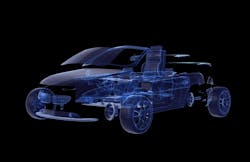In January, Jason Bigelow and his wife, Janet, changed the name of their New Jersey repair business from Advanced Tire & Auto Center to Advanced ADAS Calibration Centers—making it the only ADAS calibration center in New Jersey.
The Bigelows have been in business for 24 years, since 1995. They started their shop as a result of the technology that was lacking in the industry, Bigelow says. When the business began, all OEM software was considered proprietary, and wasn't available to the aftermarket. They spent most days diagnosing vehicles, and then were forced to send a majority of the cars to the dealership for repairs.
Years after opening, the Clean Air Act came along, as well as the Right to Repair act, giving consumers and independants access to the same software available to dealerships. Now, Bigelow says he owns 21 factory scan tools, and diagnostics is all his business does, including ADAS calibrations.
“Any car that is from 2017 on, has some type of introduction to an ADAS system,” Bigelow says.
Considering vehicles with ADAS are so new and most likely still under warranty, Bigelow says they didn’t see a large volume of them from consumers. So, they have turned to the collision repair industry, with the pitch that they can offer insurers a dealer alternative—calibrations at a much more attractive price point.
The volume of work is what prompted the name change, the opening of a second location, and a plan for a third. But the ADAS calibration success hasn't come without costs.
The Set-Up
The Bigelows have provided calibration services for some time now, but quickly recognized the issue of limited space.
“What’s required for ADAS calibration is 30 feet of cleared space on either side of the car and 60 feet in the front and back,” Bigelow says.
In January, he made the decision to remove two lifts out of the shop’s bays to create more open space and a controlled environment.
“We use factory OE targeting systems and factory OE-level software” Bigelow says. “The reason we do that is because many vehicles from 2017 forward are equipped with radar to allow for emergency braking—if that radar unit is uncalibrated by one millimeter, you lose 50 feet of braking.”
The business’s recent second location is a space used solely for calibrations on damaged vehicles sent from insurance agents. Overall, both locations have an average monthly car count of just over 300 and an annual revenue of $1.8 million.
The Technology
“We’re basically IT professionals; everything is laptop-based, cloud-based—these cars are basically rolling computers,” Bigelow says.
The field has become very analytical and technical, he says. Ten years ago, if a car had two computers in it, it was considered advanced. Now, Bigelow says that most cars he sees come in have over 200.
“Ninety percent of what we do is in our heads, and we only work 10 percent with our hands, where before it was the other way around,” he says.
They have also made a big push to educate customers about the ADAS technology, considering many don't trust the technology yet.
“Customers either love it (ADAS systems) and fully embrace it, or they try and turn everything off,” Bigelow says.
The Rebrand
Any business rebrand is bound to spark customer confusion, and especially if it includes a few unknown words and acronyms.
To combat confusion and spark education, the Bigelows sent out press releases, monthly news articles posted on Facebook, Instagram and in the local newspaper, as well as participated in television interviews to further explain the acronym to their customers and the public.
“We’re trying to educate customers as to what ADAS actually means and what it does—how they help reduce the severity of a collision, but not completely avoid one,” Bigelow says. “This is the next evolution in the industry.”
The rebrand was necessary for the Bigelows. Throughout 2018, ADAS calibrations went up 44 percent from what they did the year prior year. In 2019, they are already up 60 percent.
“As newer models come out—those involved in a collision—70 percent of them need some sort of ADAS calibration on a system. By next year, that vehicle will need ADAS calibrations on three to four systems for the amount of technology set to be added to those vehicles,” Bigelow says.
The Pricing
Many cars need two to five calibrations to calibrate a system correctly, Bigelow says, and is typically funneled back to the dealership to complete. As an alternative business model, with lower prices, Bigelow’s Advanced ADAS Calibration Centers are loved by the collision repair industry insurance companies.
“We offer a much more attractive price point,” he says.
An average camera calibration at a dealership could cost anywhere between $600 to $12,000; Bigelow’s price point is almost half of the low-end of the dealership range at $325. He says that despite the lower price, he uses the same equipment and the same training as dealerships.
The Investment
Bigelow says that Advanced ADAS Calibration Centers are the only ADAS calibration centers in New Jersey because of the steep investment—in money, technology, tools, systems, space, and training. Bigelow has been accruing the above investments for years, which he also suggests other owners do.
“The price point scares people away, it’s a super large investment,” Bigelow says.
He says that he has invested just under $1 million overall, in targeting systems, factory scan tools, and training people. He also says that it will take three to five years just to begin to recoup the costs.
But not joining the ADAS calibration movement may set your shop behind.
As a place to start, Bigelow suggests taking your most popular manufacturer and purchase that scan tool. Become familiar with the tool and ease into it. Once comfortable with the tool, then begin purchasing their ADAS targets and start to perform ADAS calibrations. Once you have a bunch of cars under your belt, then go to the next most popular car, and purchase that tool.
“We’ve always made our living staying ahead of the curve, it’s been our mission since day one,” Bigelow says.



